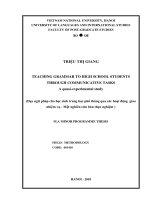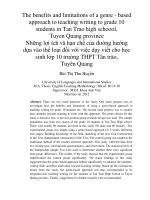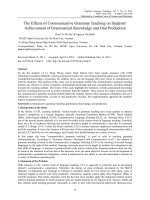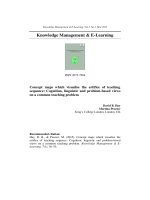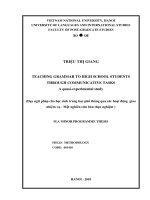A study on the effects of teaching grammar to grade 9 students based on deductive approach versus inductive approach a case study at tu mo rong secondary school
Bạn đang xem bản rút gọn của tài liệu. Xem và tải ngay bản đầy đủ của tài liệu tại đây (4.57 MB, 116 trang )
MINISTRY OF EDUCATION AND TRAINING
QUY NHON UNIVERSITY
VÕ THỊ NGỌC LỄ
A STUDY ON THE EFFECTS OF TEACHING GRAMMAR TO
GRADE 9 STUDENTS BASED ON DEDUCTIVE APPROACH
VERSUS INDUCTIVE APPROACH:
A CASE STUDY AT TU MO RONG SECONDARY SCHOOL
Field: Theory and Methodology of English Language Teaching
Code: 8140111
Supervisor: TRUONG VAN DINH, PhD
Binh Dinh - 2023
BỘ GIÁO DỤC VÀ ĐÀO TẠO
TRƯỜNG ĐẠI HỌC QUY NHƠN
VÕ THỊ NGỌC LỄ
NGHIÊN CỨU HIỆU QUẢ SỬ DỤNG PHƯƠNG PHÁP
DIỄN DỊCH VÀ QUY NẠP TRONG GIẢNG DẠY NGỮ PHÁP
CHO HỌC SINH LỚP CHÍN -
NGHIÊN CỨU CỤ THỂ TẠI TRƯỜNG THCS TU MƠ RƠNG
Ngành: Lí luận và phương pháp dạy học bộ môn tiếng Anh
Mã số: 8140111
Người hướng dẫn: TS. Trương Văn Định
BÌNH ĐỊNH - 2023
i
DECLARATION
I hereby certify that the thesis entitled ‘A study on the effects of
teaching Grammar to Grade 9 students based on deductive approach versus
inductive approach: A case study at Tu Mo Rong Secondary School’ is the
result of my own research in the fulfilment of the requirement for the Degree
of Master of Arts.
I have not utilized any sources other than those cited in the references.
Furthermore, I affirm that this thesis has not been submitted in any other
institution to obtain a degree.
Binh Dinh, 2023
Researcher
Vo Thi Ngoc Le
ii
ACKNOWLEDGEMENTS
Without the support, encouragement, and contributions from my
supervisor, colleagues, friends and family, the successful completion of this
study work would not have been possible. I take this chance to appreciate
them for their useful advice and invaluable comments, and time. They have
always been by my side and helped me enriched my knowledge and made my
master thesis graduate journey a memorable chapter in my life.
First and foremost, I am grateful to my supervisor, Ph.D. Truong Van
Dinh, for his amazing supervision. His knowledge and profession teaching-
related expertise inspired me greatly during my M.A. course at Quy Nhon
University, and he opened new horizons for me in every field. I profoundly
appreciate his accommodating guidelines and suggestions, great patience, and
strong management skills in helping me resolve the obstacles whenever I had
difficulties in my study. I am very lucky to have had him support me for my
work.
Next, I would like to acknowledge all my teachers at Department of
Foreign Languages, Quy Nhon University, Binh Dinh, for their interesting
lectures which enable me to gain a great deal of theoretical knowledge and
practical experience.
I am also indebted to all the students and teachers at Tu Mo Rong
Secondary School for their cooperation and participation in this study.
Last but not least, my heart-felt gratitude goes to my family for their
encouragement and support, without which I might face obstacles during the
process of implementing the study and completing my thesis.
iii
ABSTRACT
An instructional approach that has been proved to be effective in one
teaching context might not be appropriate in other pedagogical settings. This
stresses the vitality of research on instructional strategies and approaches
regardless of an abundance of well-established ones. With an endeavor to
seek an effective approach to teach English grammar in Vietnamese contexts,
this thesis reports the results of an empirical study in which the inductive and
deductive approach was applied to teach the English present perfect tense to
Vietnamese 9th graders in Tu Mo Rong Secondary School, a secondary in Kon
Tum province. The study employed a quantitative design in which the two
approaches were used to teach two different groups of students (a control
group and an experiment group) and a pre-test and a post-test were used to
evaluate the effectiveness of the two teaching approaches. The findings from
the participants’ test-based scores revealed that those taught with the
deductive approach outperformed their counterparts who were exposed to the
inductive approach. Besides, no major differences were found with respect to
males and female participants’ achievement of the present perfect tense after
their learning experience. These findings suggest that the deductive approach
to grammar teaching can be more productive in a Vietnamese EFL context in
comparison with the inductive approach. Considering this study’s context,
sample size and participants’ characteristics, suggestions for applying its
findings into other similar pedagogical settings are elucidated. Besides, the
limitations of the study are also discussed, from which suggestions for further
studies are provided.
iv
TABLE OF CONTENTS
DECLARATION .............................................................................................. i
ACKNOWLEDGEMENTS............................................................................ ii
ABSTRACT ....................................................................................................iii
TABLE OF CONTENTS............................................................................... iv
LIST OF ABBREVIATIONS ....................................................................... vi
LISTS OF FIGURES AND TABLES.......................................................... vii
CHAPTER 1. INTRODUCTION .................................................................. 1
1.1. Rationale ................................................................................................ 1
1.2. Aim and Objectives of the Study ......................................................... 5
1.2.1. Aim of the Study............................................................................... 5
1.2.2. Objectives of the Study..................................................................... 5
1.3. Research Questions ............................................................................... 6
1.4. Scope of the Study ................................................................................. 6
1.5. Significance of the Study ...................................................................... 7
1.6. Organisation of the Study .................................................................... 7
CHAPTER 2. THEORETICAL BACKGROUND AND LITERATURE
REVIEW .......................................................................................................... 9
2.1. Grammar and Language Learning ..................................................... 9
2.1.1. Defining Grammar........................................................................... 9
2.1.2. Roles of Grammar in Language Learning ................................... 11
2.2. Present Perfect Tense ........................................................................ 13
2.2.1. Forms.............................................................................................. 13
2.2.2. Meaning and Uses.......................................................................... 14
2.3. Grammar Teaching ............................................................................ 18
2.3.1. Ups and Downs of Grammar Teaching ........................................ 18
2.3.2. Approaches to Grammar Teaching ............................................... 22
2.4. Previous Studies .................................................................................. 28
v
CHAPTER 3. METHODOLOGY ............................................................... 31
3.1. Research Design .................................................................................. 31
3.2. Research Setting .................................................................................. 32
3.2.1. English Teaching and Learning at Tu Mo Rong Secondary School .... 32
3.2.2. English 9 Textbook and Grammar Teaching ............................... 33
3.3. Participants.......................................................................................... 32
3.4. Materials Development and Teaching Procedures .......................... 35
3.5. Data Collection and Analysis ............................................................. 38
3.5.1. Data Collection............................................................................... 38
3.5.2. Pre-test and Post-test...................................................................... 38
3.5.3. Data Analysis ................................................................................. 40
CHAPTER 4. RESULTS AND DISCUSSION........................................... 41
4.1. Effects of teaching PPT Inductively versus Deductively on Student
Learning....................................................................................................... 41
4.2. Effects of Two Teaching Approaches on Student Learning By Gender49
4.3. Which Instructional Approach Is Better: Deductive or Inductive?
...................................................................................................................... 55
CHAPTER 5. CONCLUSION AND IMPLICATIONS ............................ 63
5.1. Conclusion............................................................................................ 63
5.2. Limitations of the Study ..................................................................... 64
5.3. Pedagogical Suggestions ..................................................................... 64
5.4. Suggestion for Further Research....................................................... 66
REFERENCES .............................................................................................. 67
APPENDICES
vi
LIST OF ABBREVIATIONS
EFL English as a foreign language
PPT Present perfect tense
CLT Communicative language teaching
TPR Total Physical Response
L1 First language/mother tongue
L2 Second/foreign language
vii
LISTS OF FIGURES AND TABLES
FIGURES
Figure 1.1. Teaching Activities for Simple Past in English 9 Textbook................3
Figure 1.2. Position of PPT in English 9 Textbook.................................................4
Figure 2.1. Uses of PPT...........................................................................................15
Figure 2.2. Uses of PPT...........................................................................................16
Figure 2.3. Uses of PPT...........................................................................................17
Figure 2.4. Sequence of a Grammar Activity ........................................................21
Figure 2.5. Inductive versus Deductive Approaches.............................................27
Figure 3.1. Research Design ...................................................................................34
Figure 3.2. Teaching Activities for PPT in English 9 Textbook...........................32
Figure 4.1. Comparison of Results of Pre-test and First Part of Post-test............42
Figure 4.2. Comparison of Mean Values of Pre-test and First Part of Post-test..44
Figure 4.3. Description of Results of Pre-test and First Part of Post-test.............45
Figure 4.4. Range of Test-based Scores of First Part of Post-test of the Two
Groups ................................................................................................... 46
Figure 4.5. Comparison of Results of Second Part of the Post-test......................47
Figure 4.6. Description of Results of Second Part of Post-test.............................48
Figure 4.7. Range of Test-based Scores of Second Part of Post-test of the Two
Groups ................................................................................................... 49
Figure 4.8. Comparison of Results of First Part of Post-test Between Male and
Female Participants ..............................................................................50
Figure 4.9. Description of Results of First Part of Post-test Between Male and
Female Participants ..............................................................................51
Figure 4.10. Range of Test-based Score of First Part of Post-test Between Male
and Female Participants.....................................................................52
viii
Figure 4.11. Comparison of Results of Second Part of Post-test Between Male
and Female Participants.....................................................................53
Figure 4.12. Description of Results of Second Part of Post-test Between Male
and Female Participants.....................................................................54
Figure 4.13. Range of Test-based Score of First Part of the Post-test Between
Male and Female Participants ...........................................................55
Figure 4.14. Overall Comparison of Participants’ Achievements Between Two
Groups ................................................................................................. 57
Figure 4.15. Overall Description of Participants’ Achievements Between Two
Groups ................................................................................................. 59
Figure 4.16. Overall Comparison of Participants’ Achievements Between Male
and Female Participants.....................................................................60
Figure 4.17. Overall Description of Participants’ Achievements Between Male
and Female Participants.....................................................................61
TABLES
Table 1.1. Students’ Grammar Test Results at Tu Mo Rong Secondary School..2
Table 3.1. Materials Development and Teaching Procedures ..............................36
Table 3.2. Question Items in Pre-test and Post-test ...............................................39
1
CHAPTER 1. INTRODUCTION
This chapter introduces the rationale underlying this current study. The
chapter comprises six parts: rationale, aim and objectives, research
questions, scope, significance and organization of the Study.
1.1. Rationale
Undoubtedly, teaching grammar holds a crucial role in teaching English
as a foreign language (EFL), as without good command of grammar, the
language use will be constrained. Despite the changes in the significance
attributed to grammar instruction, most of which attach to a particular
language teaching method, it is undeniable that grammar instruction leads to
high levels of linguistic competence. In the case of grammar, apparently,
different teachers might have appropriate methods for teaching grammar based
on their experience. Some can conduct it inductively whereas others do it
deductively. Ellis (2006) states that:
Grammar teaching involves any instructional technique that draws
learners’ attention to some specific grammatical form in such a way
that it helps them either to understand it meta linguistically and/or
process it in comprehension and/or production so that they can
internalize it. (p. 84)
Nevertheless, it can be seen that English in both teaching and learning has
traditionally been dominated by a Grammar-Translation method. Though,
very little research has been conducted with regard to teachers’ observation
and actual practices regarding grammar, especially at the secondary or high
schools where English is one of the compulsory subjects and grammar is a
must in language classrooms. Hence, it comes to be an indispensable issue to
do research. Besides, these two Inductive and Deductive approaches seem to
2
be more associated with the communicative approach, which has currently
been advocated in Vietnam.
As an essential and indispensable component of language teaching and
learning, formal instruction of grammar is still prevalent in language
classrooms (Borg, 2003). So is this in teaching and learning English at Tu Mo
Rong Secondary School; however, its teaching and learning of the English
grammar seems not to be really effective as expected. This is clearly clarified
in Table 1, which presents Tu Mo Rong Secondary School students’ grammar
test results in the most three recent years.
Table 1.1
Students’ Grammar Test Results at Tu Mo Rong Secondary School
Grade (Fairly) Good Average Poor
Academic Year
2021-2022 15% 75% 10%
2020-2021
2019-2020 10% 65% 25%
5% 60% 30%
(Source: Tu Mo Rong Secondary School)
Teaching grammar via the mainly inductive approaches, which have been
practised and promoted in Britain, Australasia, and North America (Mallia,
2014), has gained great prestige worldwide, as opposed to the mainly
deductive approaches used in other countries, possibly because greater learner
motivation and better understanding and retention of language have been said
to be linked to it (Gollin, 1998). In actuality, there may be a disconnect
between what Western teachers perceive to be the most appropriate model of
teaching, and the preferred and most effective ways in which the learning of
English takes place. Therefore, Mallia (2014) warned that because the
3
inductive approach for grammar instruction has been often unquestioningly
considered to be superior for ages, teaching materials and methodologies are
therefore often similar and used these teaching approaches indiscriminately
worldwide. This warning is worth considering because there are substantial
differences among learning and teaching situations around the world (Swan,
2006), and time constraints, local cultural perceptions on language learning,
class sizes and exam-culture mentality may seriously impact on grammar
teaching (Mallia, 2014). This practice actually occurs in Vietnam, where the
textbooks using language classrooms are mainly inductive. For example, in
Unit 1-A Visit from a Pen Pal, English 9 Textbook (p.11), which is currently
used at Tu Mo Rong Secondary School, the simple past tense is suggested to
be taught inductively as follows:
Figure 1.1
Teaching Activities for Simple Past in English 9 Textbook
(Source: Nguyen et al., 2011, p.11)
4
A sizable number of corpus-based studies have noted that the present
perfect tense (PPT) enjoys a wider range of uses in the English language (e.g.,
Lessness, 2009; Hundt & Smith 2009) in various text types (Yao & Collins,
2012). This popularity of PPT is also reflected in English 9 Textbook. Figure
1 presents the position of PPT in this textbook, with the bold unit being where
the tense is the main focus of the lesson and the others being where the tense
appears, or where students need the knowledge of PPT in their learning
process.
Figure 1.2
Position of PPT in English 9 Textbook
Listen and Read Listen and
read (p.17) (p.25) read (p.32)
Read
(p.13)
Language Listen
focus (p.19) (p.35)
Unit 2 Unit 3 Unit 4 Read
Unit 5 (p.43)
Write PRESENT Unit 6
(p.11) PERFECT Language
focus (p.45)
Unit 1
Listen and
Listen read (p.47)
(p.86)
Unit 10
Listen and Unit 8 Unit 7
read (p.83)
Write
Getting (p.88)
started (p.83)
Write Listen and
(p.66) read (p.57)
Language
focus (p.71)
5
Figure 1 stresses the significance of the teaching and learning PPT in EFL
contexts in general and at Tu Mo Rong Secondary School in particular, where
English 9 Textbook has been utilised. As Nguyen at al. (2013) stated that
English 9 Textbook is theme-based, and grammar is introduced in situations
and via a variety of listening, speaking, reading, and writing activities;
therefore, the failure to master a grammatical point may seriously affect
student learning in various parts of the book, which has been clearly shown in
Figure 1.2.
For all the above analysis and discussion, the author has decided to
conduct a research entitled “A study on the effects of teaching Grammar to
Grade 9 students based on deductive approach versus inductive approach: A
case study at Tu Mo Rong Secondary School”, which aims to investigate the
effectiveness of using these two opposing approaches on secondary school
students’ overall achievement of the English PPT, from which the conclusions
about the application of these two teaching approaches will be drawn and
pedagogical implications are discussed.
1.2. Aim and Objectives of the Study
1.2.1. Aim of the Study
The present study aim to evaluate the effectiveness and gender differences
in using the inductive and deductive approaches to teach the English present
perfect tense to secondary school students.
1.2.2. Objectives of the Study
To achieve the aim, the present study is intended:
(1) to find out about Tu Mo Rong Secondary School students’ overall
achievements of the English present perfect tense when taught with the
inductive and deductive approaches;
6
(2) to examine whether there are any differences in Tu Mo Rong
Secondary School male and female students’ achievements of the
English present perfect tense when taught with the inductive and
deductive approaches;
(3) to determine whether the inductive or deductive are beneficial to teach
grammar to Tu Mo Rong Secondary School students.
1.3. Research Questions
The present study attempts to answer the following research questions:
(1) What is the effectiveness of teaching PPT inductively versus
deductively to Tu Mo Rong Secondary School students’ overall
achievements of the English present perfect tense?
(2) Are there any differences in Tu Mo Rong Secondary School male and
female students’ achievements of the English present perfect tense
when taught with the inductive and deductive approaches?
(3) Which instructional approach is better for Tu Mo Rong Secondary
School students’ acquisition of the English present perfect tense:
deductive or inductive?
1.4. Scope of the Study
Due to the limitations of a minor study, the author only carried out
research on a small number of students at a secondary school. The study
focuses also on the effectiveness of the use of inductive versus deductive
approaches to teach the present perfect tense with the contents stipulated in
Tiếng Anh 9 coursebook to Tu Mo Rong Secondary School’s grade 9
students.
7
1.5. Significance of the Study
Theoretically, the present study summarized the theory of the English
PPT, grammar instruction in general and the deductive and inductive
approaches to teaching grammar in particular. These sources of information
can be useful for other researchers and classroom practitioners, who would
like to do further research in this field and who intend to apply these teaching
approaches in their classrooms.
Practically, the present study provides language teachers with evidence-
based advice on the use of the deductive and inductive approaches to teaching
English grammar to Vietnamese secondary students, based on their grammar
achievements. The present study also provides language teachers and learners
with a number of activities, exercises and teaching and learning frameworks
associated with the teaching and learning the English PPT, all of which were
listed in Appendix A.
1.6. Organisation of the Study
This thesis is divided into five chapters.
The first chapter, Introduction, discusses the rationale for the present
study. It also clarifies the scope of the study, its aim and objectives and
research questions as well. The organization of the study is also included in
this chapter and serves as an outline which directs readers to subsequent
sections.
The second chapter, Theoretical Background and Literature Review,
states the fundamentals of grammar, grammar instruction, and the English
PPT and provides a brief overview of the deductive and inductive approaches
to grammar teaching, which establishes the theoretical background for the
8
design of the present study. The previous studies related to this study is also
listed and discussed here to figure out unsolved problems in the fields.
The third chapter, Methodology, includes information relating to the
methods and procedures employed in the study. That is, the research design,
treatment stage, data collection and data analysis for implementing the thesis
are discussed in this chapter. Thus, this chapter provides the framework for
generating the result in the subsequent chapter.
The fourth chapter, Results and Discussion, represents the results and
discussed the findings. It focuses on answering the research questions on the
effectiveness of the use of the deductive and inductive approaches to teach the
English PPT, from which teaching English grammar to Vietnamese secondary
students can be drawn.
The last chapter, Conclusion and Implications, summarizes the main
points discussed in the previous parts of the study and the major findings of
the research, which provides the ground for the discussion of the implications
for learning and teaching English grammar with the deductive and inductive
approaches. Besides, the limitations of the study and suggestions for further
study is also mentioned in this chapter.
9
CHAPTER 2. THEORETICAL BACKGROUND AND
LITERATURE REVIEW
Chapter 2 presents the study’s theoretical background with Grammar and
Language Learning, followed by present perfect tense, grammar teaching.
2.1. Grammar and Language Learning
2.1.1. Defining Grammar
Learners might face a number of problems when they learn a language.
For instance, they commonly have to deal with the complicated rules of the
language or the inappropriate performance of strategies from their schools.
Specifically, they often do not know what to pay attention to; therefore, there
might be a tendency that the discrepancy frequently occurs between students
and their teachers on the use of Grammar resulting in negative effects. One of
the first people who did research on Grammar-based teaching, Krashen
(1981) points out that:
Grammar instruction played no role in acquisition, a view based on the
conviction that learners (including classroom learners) would
automatically proceed along their built-in syllabus as long as they had
access to comprehensible input and were sufficiently motivated.
Grammar instruction could contribute to learning but this was of
limited value because communicative ability was dependent on
acquisition. (p. 85)
Sharing this view, Harmer (1987) adds:
Without some understanding of grammar, students would not be able to
do anything more than utter separate items of language for separate
functions. The expression of functional language is only possible
through the use of the Grammar of the language. (p. 12)
10
The term “grammar” has continually been a controversial subject of
research due to the fact that it helps students understand how the language
works in every utterance. It has been placed in a central position in the
context of language teaching and the concept of grammar has been variously
defined from the original viewpoints to the current perspectives. Despite its
common usage, there are multiple definitions of Grammar with the
corresponding scholars. At the end of the 20th century, Harmer (1987)
presents the expression of Grammar in numerous languages “The grammar of
a language is what happens to words when they become plural or negative, or
what word order is used when we make questions or join two clauses to make
one sentence” (p.1)
Crystal (2004) defines grammar as follows:
Grammar is the structural foundation of our ability to express
ourselves. The more we are aware of how it works, the more we can
monitor the meaning and effectiveness of the way we and others use
language. It can help foster precision, detect ambiguity, and exploit the
richness of expression available in English. And it can help everyone-
not only teachers of English, but teachers of anything, for all teaching
is ultimately a matter of getting to grips with meaning (p. 24).
Higgs (1985) defines grammar as “a system for converting meaning into
language” (p.13). Tonkin (1994) furthers this definition by distinguishing
between descriptive grammar, pedagogical grammar, and psycholinguistic
grammar. Seliger (1979) points out that the goal of pedagogical grammar
rules is to cause someone to produce a language form. Rutherford and Smith
(1988) depict pedagogical grammar as follows:
Instructional strategies which draw the attention of learner to
specifically structural regularities of the language, as distinct from the


